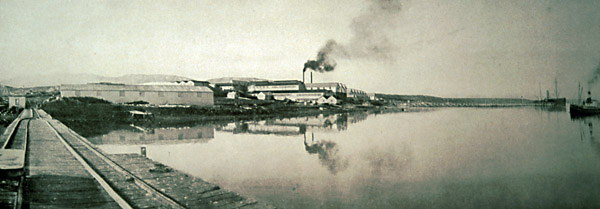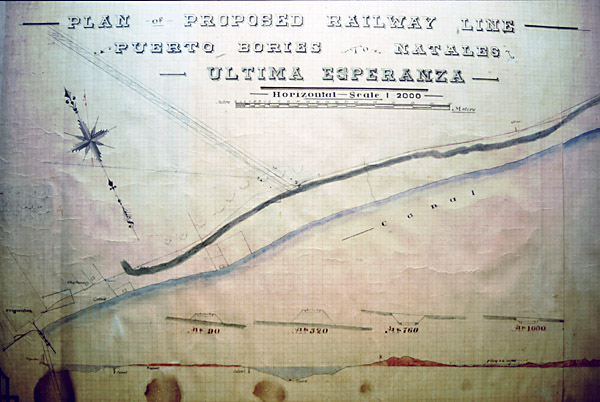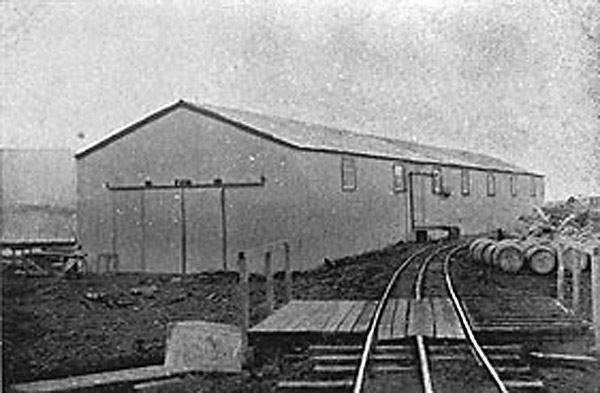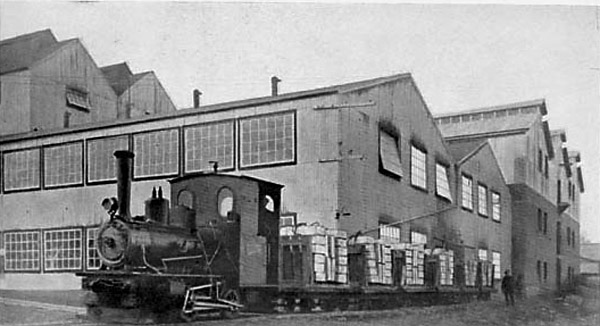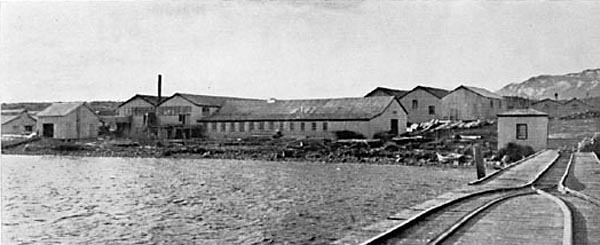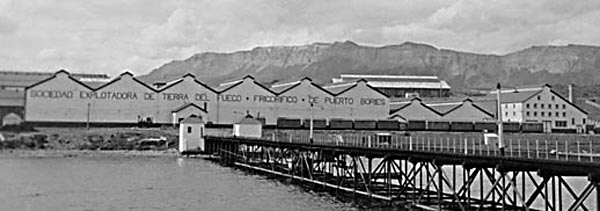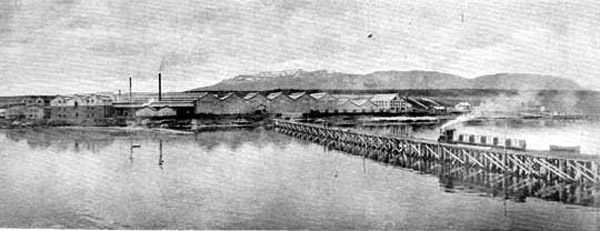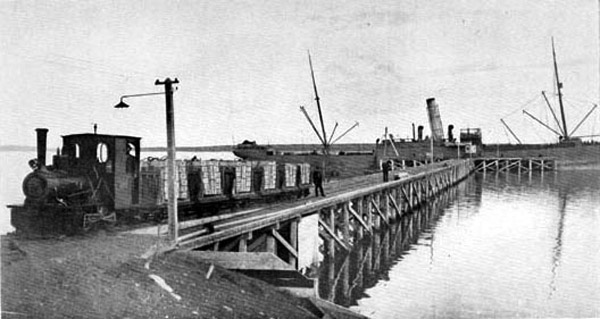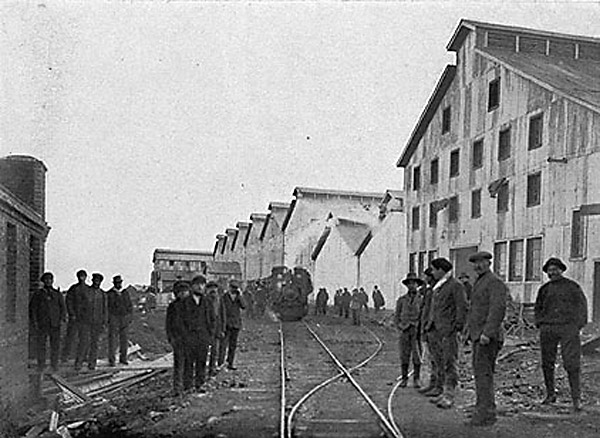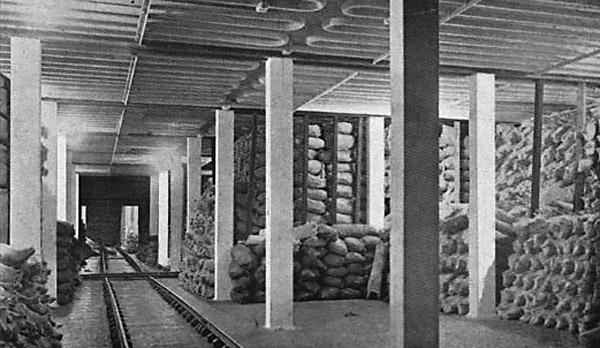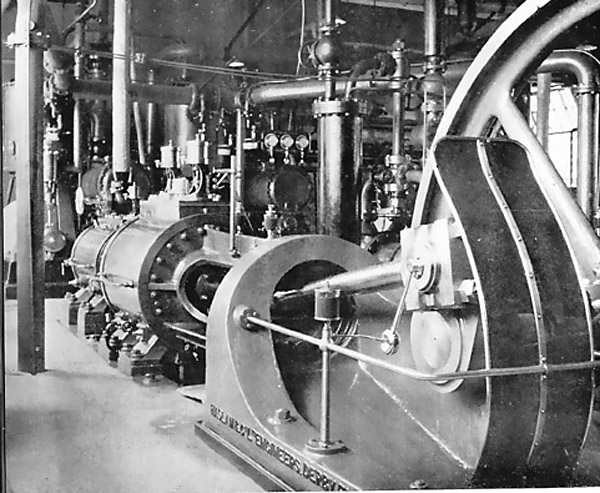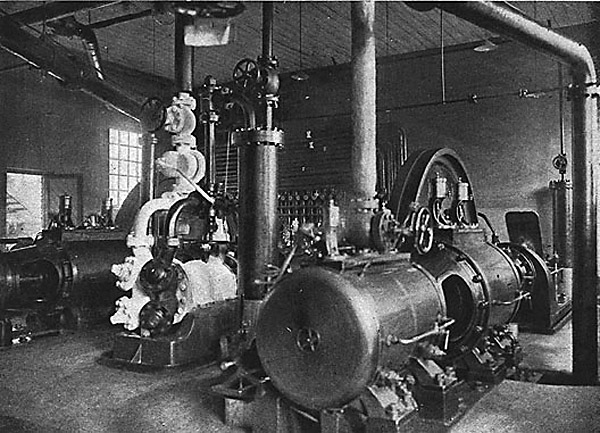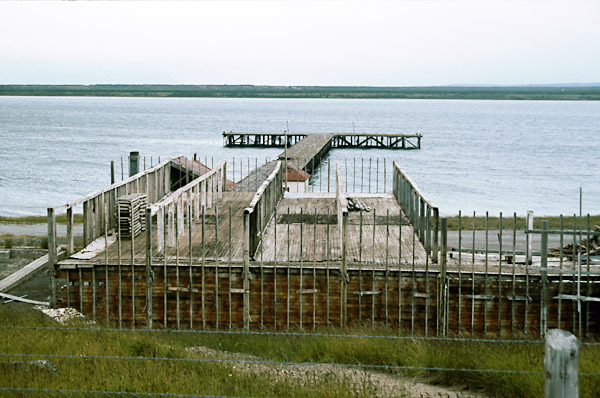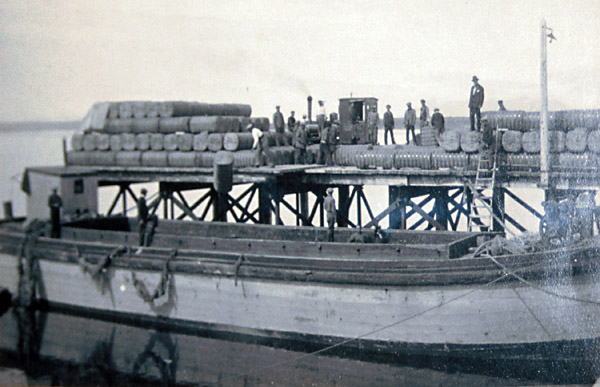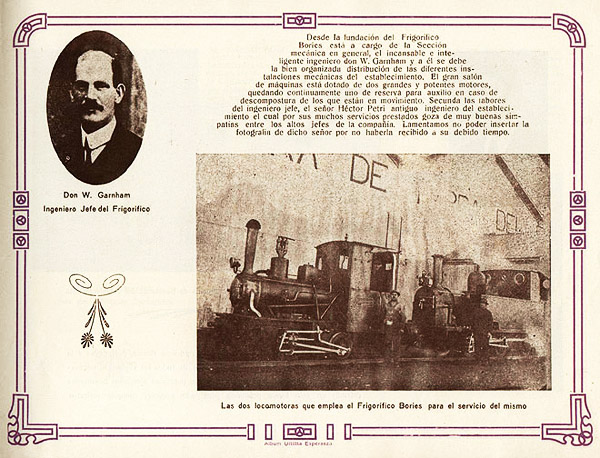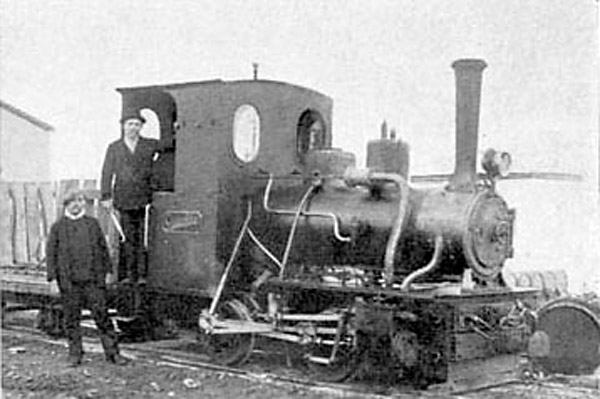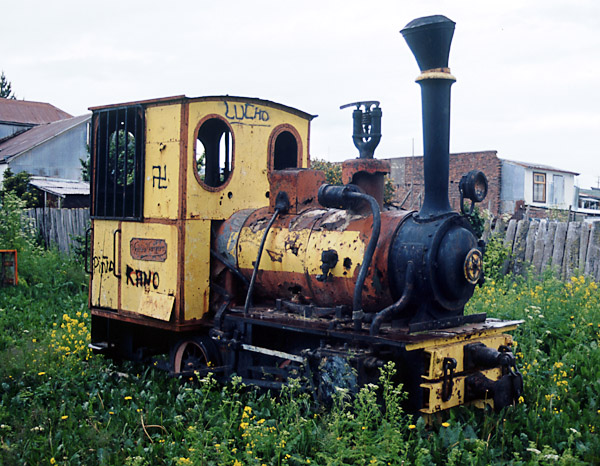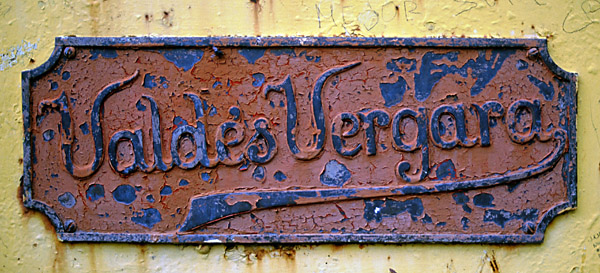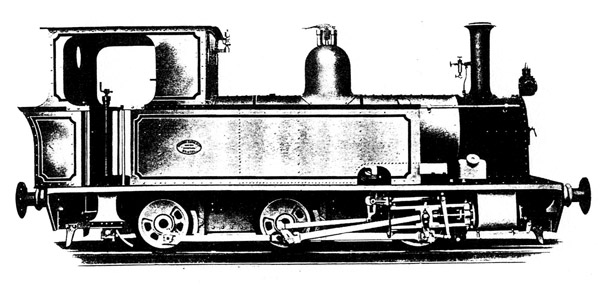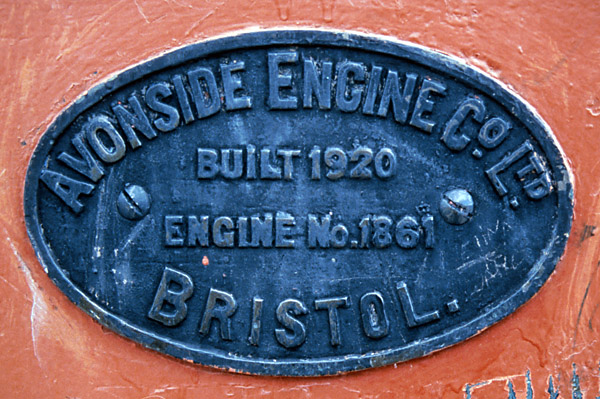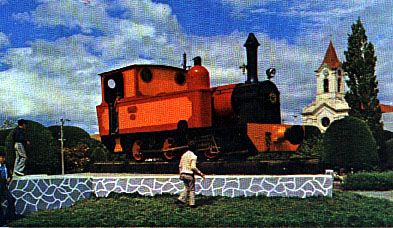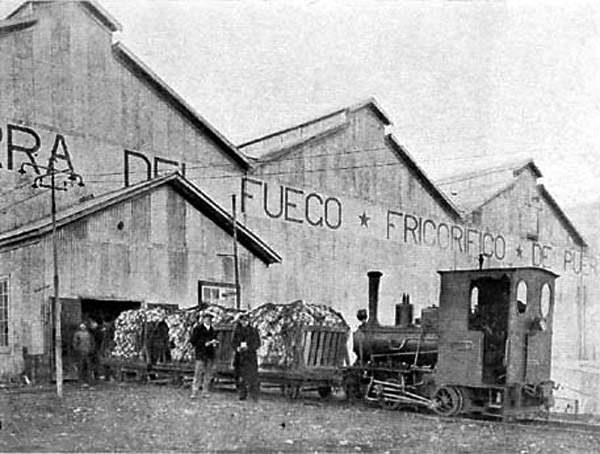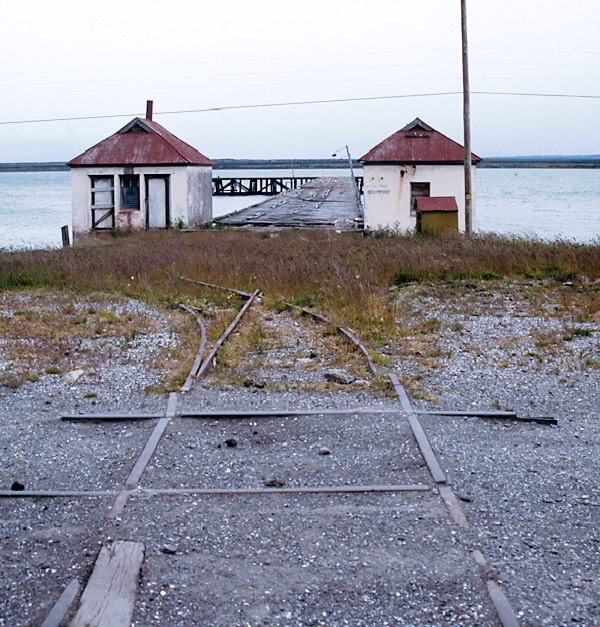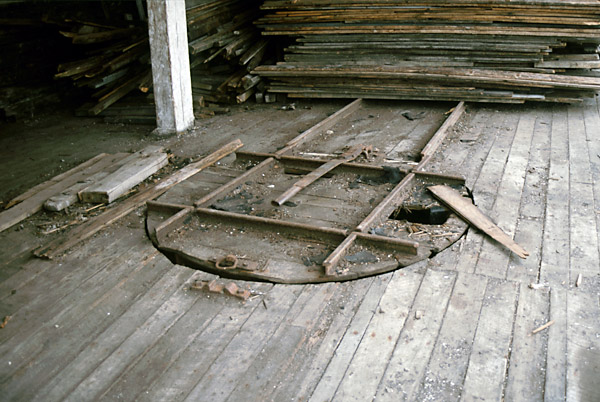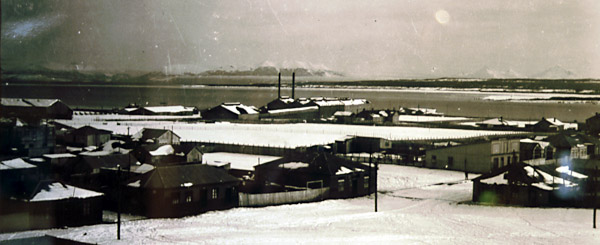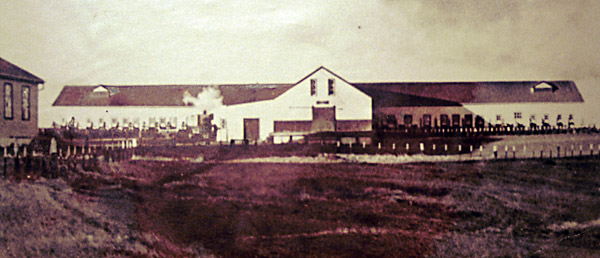 |
 |
||||||||||||||
 |
|||||||||||||||
Ultima Esperanza
Puerto Bories frigorifico
Whilst the frigorifico had its own jetties, one of which shows up in the picture above, it was three miles away from the source of workers at Puerto Natales. This could be difficult particularly in winter when snow covered the dirt road along the shore. A passenger carrying railway The plan below, framed on the wall of a corridor at the Instituto de la Patagonia in Punta Arenas, shows the proposal. Unfortunately it is not possible to copy the whole diagram in one piece as it is a couple of yards long. The section shown has the coast as a blue line, the road as a thick grey line, and the proposed railway more faintly as a thin line just inland of the road. The frigorifico is at the extreme left and the railway travels right for a mile or so before going off this section of the plan. At the foot, faintly visible, are a number of cross-sections illustrating the alignment relative to the original ground level. The brown marks are water stains.
Along the route A steeply graded line within the grounds of the frigorifico. The purpose of the third rail is not clear.
'Guacolda', later renamed 'Valdez Vergara', the O&K 0-4-0T, on one of the higher level sidings.
Down at beach level the frigorifico had two separate muelles as well as sidings reaching into the various warehouses. The photos immediately below come from the Carlos Foresti album of 1920. The more northerly muelle was close to the sawmill which adjoined the frigorifico.
The other, from which the carcasses were shipped, was directly in front of the main frigorifico buildings.
This picture shows it with a train headed by the O&K loco. Note that this photo appears to show the jetty cponstructed in wood, whilst the previous photo clearly illustrates an iron muelle. It seems likely that the wooden structure was an earlier version.
A view from the other end, also with the O&K at the head of a train.
The O&K loco is here ready to depart along the mainline eastward toward Pto. Natales. Judging by the large number of men standing about, this may be at clocking-off time.
A view inside the cold store.
An impressive compound engine, built in Derby though the company name has not been deciphered. A second one is out of picture to the right.
Another view of what is probably the same pair of engines.
In the picture below a wood-framed building in course of demolition hides the head of one of the muelles.
At this level the 'mainline' set off south-eastwards along the coast.
The next picture, by Andy Kirkham of Glasgow, illustrates the old alignment clearly showing up in the grass as it runs parallel to the now surfaced road. Puerto Natales is behind the photographer, who was looking back towards Puerto Bories.
At Puerto Natales the railway connected to at least one jetty. The photo below shows wool bales awaiting shipment probably from the short Pto. Natales muelle. (2). Whether these had been brought along the railway from Puerto Bories or had arrived from elsewhere or indeed from a shearing shed at the Puerto Natales frigorifico is not clear.
Locomotives The two steam locos are seen together in this view from Carlos Foresti's 1920 album Vistas del Frigorífico de Puerto Bories, published by the owners, the Sociedad Explotadora de Tierra del Fuego.
'Guacolda' The loco shown below labelled as 'Guacolda', is a 20HP O&K product, and may have been works no. 6962 of 1913, delivered via Messrs. Duncan Fox. The Pto. Bories plant was not opened until 1914, but the loco may have been purchased for use on construction trains or may have seen use elsewhere before arriving at Pto. Bories.
'Valdés Vergara' The only major differences from the engine illustrated above are in the small spark arrestor, and the larger safety valves mounted on the dome. This loco has been on display in the past but in January 2001 was stored in the yard behind the town museum.
The current plate on the cabside of the surviving loco.
'McLelland' A side view of the design was later displayed in the Avonside catalogues of the 1920s. It was designated the NJ class and was available for gauges between 2' and 3' 6". In working order it weighed twelve and a half tons.
The worksplate as pictured by Andy Kirkham of Glasgow in 1995.
Wilfred Simms suggests (5) that this loco was delivered via the agent Duncan Fox. (Sir) Peter/Pedro McLelland was for many years the managing director of the 'Explotadora'.
The photo below was supplied by Señor Raúl Moroni. It shows the Avonside on a train, probably at the frigorifico gates. The date is unknown.
This engine has been on a plinth in the square at Puerto Natales since the line's closure.
The photo below was taken from a postcard of the early 1970s. At present the loco is in a more sober green and black with white rods, but has suffered a little from graffiti writers.
The Ruston diesel
Rolling stock The view below from the 1950s shows 'Guacolda' or 'Valdes Vergara' hauling five bogie passenger vans and one smaller van along the mainline towards Puerto Natales (8). Hung on the outside of each van are sheep carcases being taken home by the workers. This was one of the 'perks' of the job!
Within the frigorífico and out along the muelles, four wheeled open wagons were used. These appear to have had slatted wooden ends to support the piles of frozen carcases. The photo below from the Forresti album shows a loco drawing three wagons out of the front of the plant possibly onto the main muelle.
Political upheavals
Closure
A number of relics of the railway were visible in 2001. Above can been seen track heading for one of the muelles. Below is a wagon turntable amid the ruins of one of the warehouses. A new muelle in Puerto Natales is largely constructed from old rails, but the weight (60-70lbs per yard) of the heavier ones makes one think that they might have been shipped down from some mainline further north in Chile.
More photos Puerto Natales frigorifico
It is likely that there were railway tracks around the site, as in every other similar frigorifico, but I have no details of their nature, or whether they connected to the Puerto Bories line. The photo below shows a small locomotive outside a 'galpon de esquila' or sheep shearing shed. Whilst the photo was found in the Pto. Natales museum, Duncan Campbell does not believe that it was taken at Puerto Bories, so it may show a location within the Pto. Natales frigorifico site.
References: 29-10-11 |
|||||||||||||||
Main pages
Chapter 8
The big estancias and 'frigoríficos'


